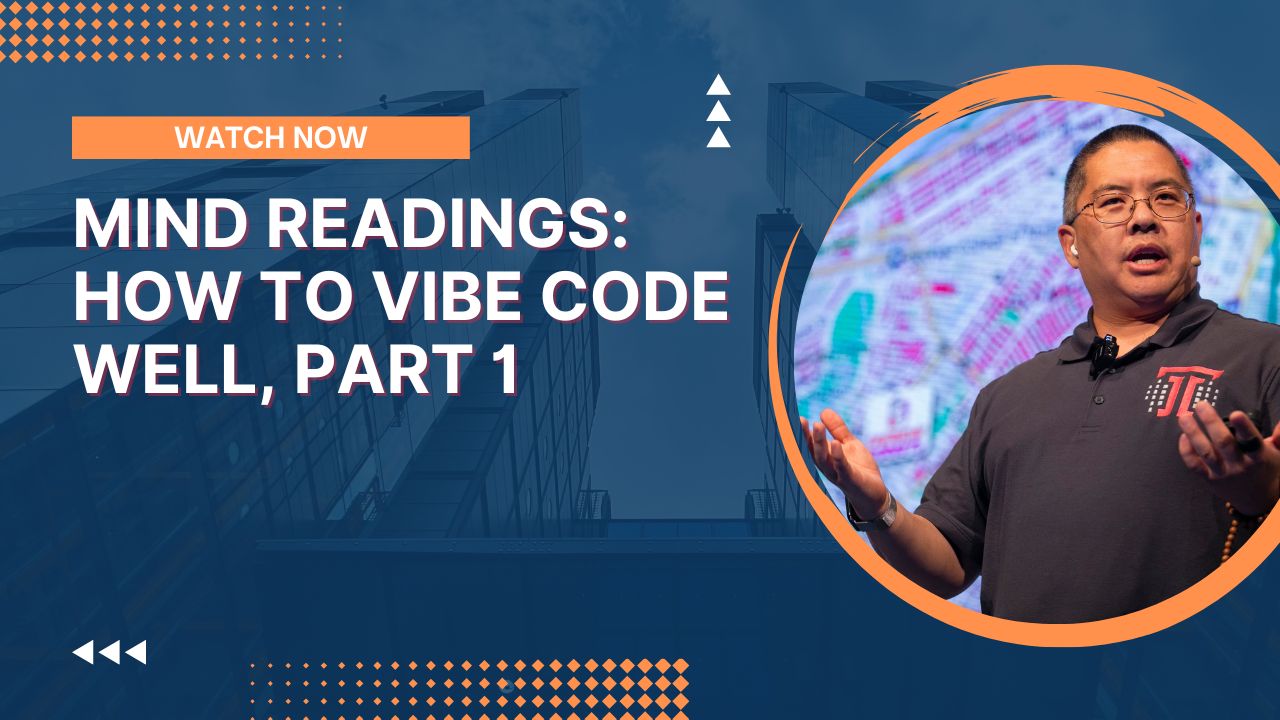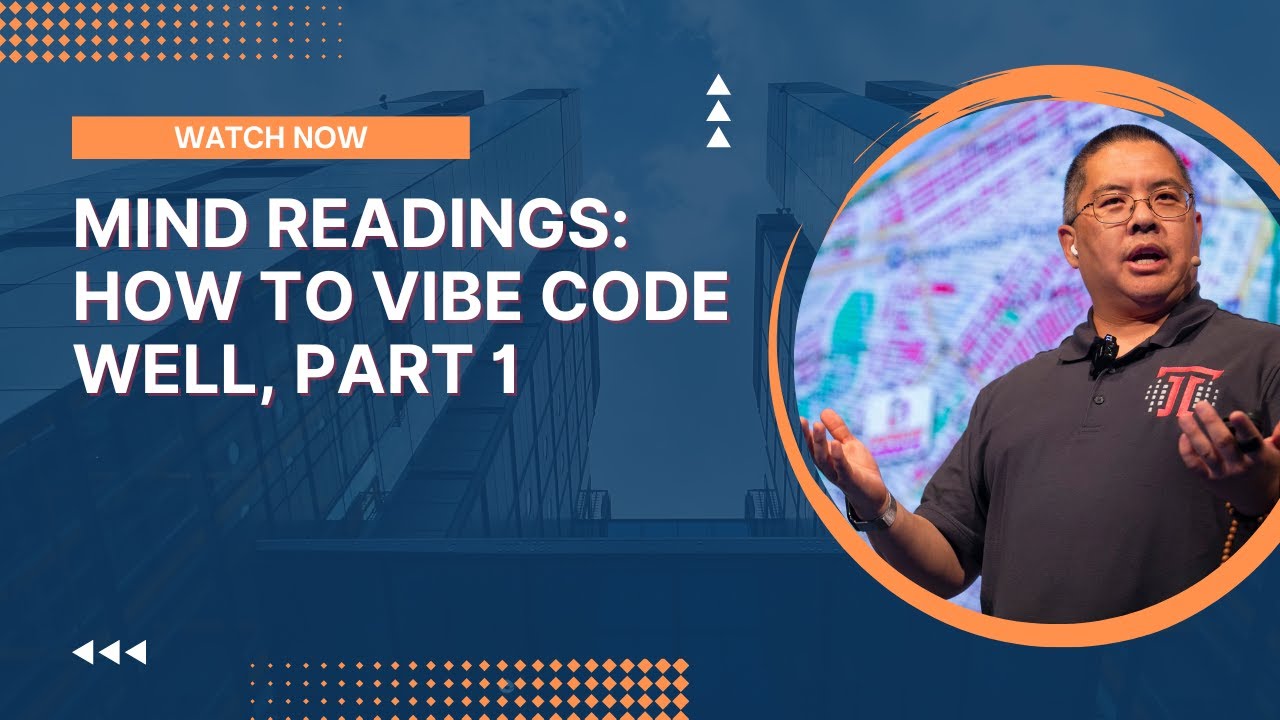Mind Readings: How to Vibe Code Well, Part 1
Description

In this episode, unlock the secrets to inexpensive AI-assisted coding. You will discover a powerful two-model strategy to build your projects without breaking your budget. You will learn how to set up your coding environment and choose the right AI tools for maximum efficiency. You will gain essential frameworks for developing new software, ensuring your projects solve real problems effectively. Watch now and transform your approach to creating with AI.

Watch this video on YouTube.
Can’t see anything? Watch it on YouTube here.
Listen to the audio here:
- Take my new Generative AI course!
- Got a question for You Ask, I'll Answer? Submit it here!
- Subscribe to my weekly newsletter for more useful marketing tips.
- Subscribe to Inbox Insights, the Trust Insights newsletter for weekly fresh takes and data.
- Find older episodes of You Ask, I Answer on my YouTube channel.
- Need help with your company's data and analytics? Let me know!
- Join my free Slack group for marketers interested in analytics!
Machine-Generated Transcript
What follows is an AI-generated transcript. The transcript may contain errors and is not a substitute for watching the video.
In this series, let’s talk about how to do vibe coding well, properly, and as inexpensively as possible. A lot of folks are making note of the fact that new models like Claude 4, Gemini 2.5, and OpenAI 03 are really capable, really smart. Then, when they use them to do vibe coding, they get really big bills, because state-of-the-art foundation models are good, but they are not cheap. So, I’m going to walk you through the process I use to do vibe coding, to do it reasonably well, to do it in a way that is very, very inexpensive, and to do it in a way that makes good sense.
So, before we begin some preparation—some mise-en-place, if you will—you will need to adopt the philosophy of “plan big, act small.” Plan big, act small. What this means is we use a very large model, such as Gemini 2.5 or Claude 4, to do our planning, thinking, and analysis, and to come up with ideas, refine them, and build the architecture for our coding. Then, we use a small model, something like Quen3, to do the actual implementation, because all it has to do is be fluent in writing the code that we’re going to build. It doesn’t need to do any of the thinking. We want to do the thinking in the big models and the acting in the small models.
So, you will need to have access to both kinds of models. You will need a big model. For example, I’m going to use Gemini 2.5. I’ll bring up my shared screen here. Let me share my main screen. We have Gemini 2.5 Pro, which is Google’s big thinking model. That’s going to be our big one. For our small model, I’m going to open up LM Studio, which is local AI. I’ll select the Quinn 330AB 8-bit MLX that I’ve downloaded. I’m going to crank the context window as large as it will let me go. Let’s get that started. So, these are the two models we’re going to need.
You’re going to need a coding environment of some kind. I personally recommend using Klein, which is the tool I use. Klein can be found inside Visual Studio Code, or I use the open-source version called VS Codium. VS Codium is identical to Visual Studio Code, except it has none of Microsoft’s tracking information, which I find very reassuring to ensure it’s not monitoring all the stuff we’re doing.
In here, let’s provision a new project. I’ll just put it on my desktop for now, and I’m going to name it. I know what project I want to do, but I don’t want to leap too far ahead. But I’ll just put it in the folder, which we’ll call “data layer.” Inside VS Code, I’ll go to the Klein window. I’m going to make sure that I’ve checked LM Studio and that I’m using the Quinn30 model. That’s going to be my workhorse. This is where the actual coding will happen.
So, that’s the mise-en-place. That’s the big stuff you have to have in place first before you can do the vibe coding. You need the tools. Pick the model of your choice based on your hardware and capabilities. You might, for example, use DeepSeek. DeepSeek is perfectly safe to use if you are not doing anything confidential. If you’re working on, say, a public, open-source GitHub repository, and you don’t care that another company is going to be using the data, DeepSeek is a perfectly good model to use. You could even use it for both. It’s so inexpensive that it really is a good choice for that. But it is in no way, shape, or form private at all. So, you do want to be aware of that.
So, that’s the mise-en-place. Now, what are we going to do? What kinds of things could we want to vibe code? Well, vibe coding is no different from any other form of software development. You still have to follow the software development lifecycle. You still have to do things like requirements gathering, planning, coding, QA, deployment, and support, and all that stuff. Just because you’re using generative AI does not mean that software development practices go out the window. I mean, they can, but it’s not going to go well.
So, the first thing we have to think about is, what are we going to do? Why would we use vibe coding? We want to do it because we have an idea that we want to bring to life. One of the things I say in all my keynotes and talks about generative AI is that whoever has the most and best ideas will win. So, if you have no ideas, vibe coding is not going to help. There’s absolutely no way that you’re going to build something interesting if you have no ideas of your own.
One of the things you can do is think about the things you use on a day-to-day basis that maybe you like or don’t like. Maybe there’s certain software where, ah, you only need a part of it, but the manufacturer charges you for all of it. Could you make your own version? I have lost count of the number of software projects where I have done exactly that. My friend Mitch Joel was recently lamenting the loss of the software Pocket, the app that allows you to save stuff online. I said, “vibe code it.” We’re not going to do that today because that’s a very big undertaking, but we’re going to do something very similar.
Conceptually, there was a piece of software in the AI and analytics world that a lot of us used called Data Slayer. Data Slayer was a tool that allows you to inspect, do tag management, and stuff like that. However, it has not been updated in a very long time. We can see that six years is when this tool was last updated, and it’s now so out of date that we can’t use it anymore. Chrome does not allow us to use it anymore. This is an open-source project, licensed under the MIT license, which means that we can take this, fork it, and make our own version of it.
Yeah, the last version of Data Slayer was released on September 25th, 2015. Holy crap. That is—sorry, a 303 release was bumped four years ago. So, this software is essentially toast. I’m going to open up my GitHub repository, my GitHub Desktop tool here. I’m going to clone that into my own local environment. So, I now have my own version of this in GitHub Desktop, called “Data Slayer,” and all the pieces are in it. And we can look at the source code. We can see all the different stuff. This is not a bad piece of software. It’s well structured for its time.
So, the first thing we want to do is ask, “What does it do? What could it do better?” Obviously, it has to be brought up to Chrome Manifest Version 3, because Google said they’re not going to allow us to do this anymore. What did we like about it? What did we not like? I liked some of the things it had in the develop





